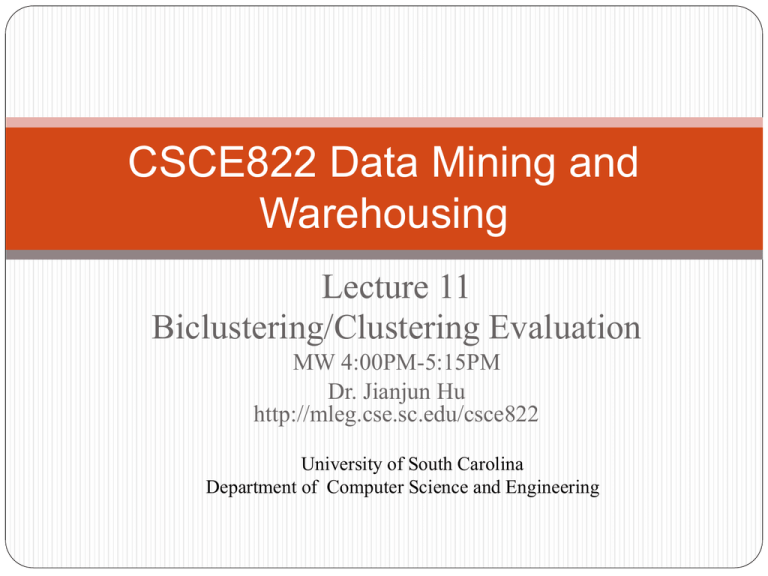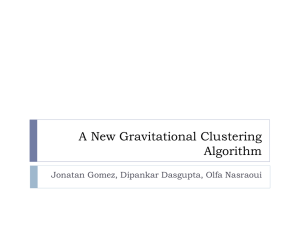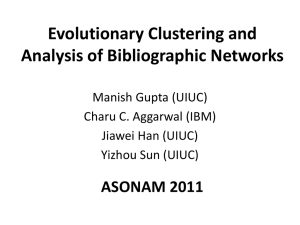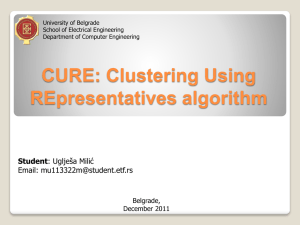Biclustering - University of South Carolina
advertisement

CSCE822 Data Mining and
Warehousing
Lecture 11
Biclustering/Clustering Evaluation
MW 4:00PM-5:15PM
Dr. Jianjun Hu
http://mleg.cse.sc.edu/csce822
University of South Carolina
Department of Computer Science and Engineering
Roadmap
Introduction to Bi-clustering
Difference between Bi-clustering and two-way
clustering
Typical Procedure for Cluster discovery
Why Cluster Validation/Evaluation?
Different methods for clustering evaluation.
4/9/2015
Clustering Analysis in Read-world: Microarray
If we observe gene activity (expression) over specified experimental conditions we can
assign putative functions to genes.
Condition 1 Normal Cells
Condition 2 Cancerous Cells
Gene A
Gene A
Normally expressed
Highly expressed
Conclusion: Gene A may be involved in onset of cancer
Microarray experiments have the capacity to analyze the expression of 10000’s of genes
over many conditions.
Clustering Analysis of Gene Expression Datasets
540
520
500
Cluster A
480
460
440
420
400
1
2
3
4
5
6
2
3
4
5
7
8
9
10
11
12
13
14
15
16
17
16
17
500
450
600
400
550
350
500
300
Clustering…
250
200
Cluster B
450
400
150
350
1
6
7
8
9
10
9
10
11
12
11
12
13
14
15
100
50
0
1
2
3
4
5
6
7
8
9
10
11
12
13
14
15
550
530
510
490
Graph of Gene Expression V’s
Conditions
470
450
430
Cluster C
410
390
370
350
1
2
3
4
5
6
7
8
13
14
15
16
17
Similar rows are grouped together into unique clusters. The premise is that each
Cluster may represent a group of functionally related genes (Biological Module).
Possible Drawbacks with Clustering:
1.
In high dimensional expression datasets similarity may not exist over all conditions.
2.
Related genes may naturally correlate
3.
Genes may have more than one function (clusters may not be disjoint but overlap).
over some conditions and not others.
With such datasets it is more beneficial to cluster the data over both rows
and columns or to employ Biclustering
Necessity is the Mother of Invention
C1
C2
C3
Traditional Clustering
Biclustering
Biclustering concept was proposed in 1960s. But rarely used or
studied until 2000 !
Biclustering: The Background
Usual clustering algorithms are based
on global similarities of rows or
columns of an expression data matrix.
But the similarity of the expression
profiles of a group of genes may be
restricted to certain experimental
conditions.
Goal of biclustering: identify
“homogeneous” submatrices.
Difficulties: computational complexity,
assessing the statistical significance of
results
Biclustering V.S. Clustering
1 2 3 4 5 6 7 8 9 10
Gene A
Gene B
Gene C
Gene D
Gene E
Gene F
Gene G
Gene H
Gene I
Gene J
Gene K
Gene L
Gene M
Clustering…
1 2 3 5 7 10
Gene A
Gene B
Gene C
Gene D
Gene K
Gene L
Bicluster {1,2,3,5,7,10}
{A,B,C,D,E,F}
Similarity does not exist over all attributes…
Solution: Cluster both Row and Columns
Simultaneously (Biclustering)
Cheng and Church (2000) introduced the concept of Biclustering to the area of gene
expression analysis.
They developed a function called the Mean Squared Residue Score to score sub-matrices
and locate those with good row and column correlation (Biclusters)
The exhaustive search for and scoring of all sub-matrices is NP-hard and they
employed a Greedy Search Heuristic in their approach.
Cheng and Church Node Deletion Approach
Cheng and Church’s greedy search approach involved deleting rows and columns from the
parent matrix which most improved the Mean Squared Residue Score. The search is
stopped upon reaching a predefined score (δ), this solution is referred to as the δ-bicluster.
Input:
δ-bicluster
Data matrix
δ = 300
Score: 543
Cheng, Y. and Church, G.M. (2000)
Biclustering of expresssion data. ISMB
2000
Score:423
Mean Squared Residue Score
Score: 1,052
Score: 300
Local Optima
Global Optimum
Solutions
Overview of the Biclustering Methods
Method
Publish
Cluster Model
Goal
Cheng & Church
ISMB 2000
Background + row effect +
column effect
Minimize mean squared residue
of biclusters
Getz et al.
(CTWC)
PNAS 2000
Depending on plugin clustering
algorithm
Depending on plugin clustering
algorithm
Lazzeroni & Owen
(Plaid Models)
Bioinformatics
2000
Background + row effect +
column effect
Minimize modeling error
Ben-Dor et al.
(OPSM)
RECOMB 2002
All genes have the same order
of expression values
Minimize the p-values of
biclusters
Tanay et al.
(SAMBA)
Bioinformatics
2002
Maximum bounded bipartite
subgraph
Minimize the p-values of
biclusters
Yang et al.
(FLOC)
BIBE 2003
Background + row effect +
column effect
Minimize mean squared residue
of biclusters
Kluger et al.
(Spectral)
Genome Res.
2003
Background row effect
column effect
Finding checkerboard structures
Clustering by Row(Genes)
Difference Between Biclustering and
Two-way clustering
Clustering by Column
Biclustering
Clustering Analysis in Real-world
Prepare the Data
Select Clustering
Algorithm
Visually Inspect the
clusters
Interpret the clusters
Too Many Clustering Algorithms? Evaluation
Cluster Validity
For supervised classification we have a variety of measures
to evaluate how good our model is
Accuracy, precision, recall
For cluster analysis, the analogous question is how to
evaluate the “goodness” of the resulting clusters?
But “clusters are in the eye of the beholder”!
Then why do we want to evaluate them?
To avoid finding patterns in noise
To compare clustering algorithms
To compare two sets of clusters
To compare two clusters
1
1
0.9
0.9
0.8
0.8
0.7
0.7
0.6
0.6
0.5
0.5
y
Rando
m
Points
y
Clusters found in Random Data
0.4
0.4
0.3
0.3
0.2
0.2
0.1
0.1
0
0
0.2
0.4
0.6
0.8
0
1
DBSCA
N
0
0.2
0.4
x
1
1
0.9
0.9
0.8
0.8
0.7
0.7
0.6
0.6
0.5
0.5
y
y
Kmeans
0.4
0.4
0.3
0.3
0.2
0.2
0.1
0.1
0
0
0.2
0.4
0.6
x
0.6
0.8
1
x
0.8
1
0
Complete
Link
0
0.2
0.4
0.6
x
0.8
1
Different Aspects of Cluster Validation
1.
2.
3.
Determining the clustering tendency of a set of data, i.e., distinguishing
whether non-random structure actually exists in the data.
Comparing the results of a cluster analysis to externally known results, e.g.,
to externally given class labels.
Evaluating how well the results of a cluster analysis fit the data without
reference to external information.
- Use only the data
4.
5.
Comparing the results of two different sets of cluster analyses to determine
which is better.
Determining the ‘correct’ number of clusters.
For 2, 3, and 4, we can further distinguish whether we want to evaluate the
entire clustering or just individual clusters.
Measures of Cluster Validity
Numerical measures that are applied to judge various aspects of
cluster validity, are classified into the following three types.
External Index: Used to measure the extent to which cluster labels match
externally supplied class labels.
Entropy
Internal Index: Used to measure the goodness of a clustering structure
without respect to external information.
Sum of Squared Error (SSE)
Relative Index: Used to compare two different clusterings or clusters.
Often an external or internal index is used for this function, e.g., SSE or entropy
Sometimes these are referred to as criteria instead of indices
However, sometimes criterion is the general strategy and index is the numerical
measure that implements the criterion.
Measuring Cluster Validity Via Correlation
Two matrices
Proximity Matrix
“Incidence” Matrix
One row and one column for each data point
An entry is 1 if the associated pair of points belong to the same cluster
An entry is 0 if the associated pair of points belongs to different clusters
Compute the correlation between the two matrices
Since the matrices are symmetric, only the correlation between
n(n-1) / 2 entries needs to be calculated.
1
2
3
1
1
2
3
0
0.5
1.0
1
0
2.0
2
0
3
2
3
1
0
1
Measuring Cluster Validity Via Correlation
High correlation indicates that points that belong to the same
cluster are close to each other.
Not a good measure for some density or contiguity based
clusters.
Measuring Cluster Validity Via Correlation
Correlation of incidence and proximity matrices for the
1
1
0.9
0.9
0.8
0.8
0.7
0.7
0.6
0.6
0.5
0.5
y
y
K-means clusterings of the following two data sets.
0.4
0.4
0.3
0.3
0.2
0.2
0.1
0.1
0
0
0.2
0.4
0.6
x
Corr = -0.9235
0.8
1
0
0
0.2
0.4
0.6
x
Corr = -0.5810
0.8
1
Using Similarity Matrix for Cluster Validation
Order the similarity matrix with respect to cluster labels
and inspect visually.
1
1
0.9
C1
0.8
y
0.6
C2
0.5
0.4
0.3
0.2
C3
0.1
0
Points
0.7
10
0.9
20
0.8
30
0.7
40
0.6
50
0.5
60
0.4
70
0.3
80
0.2
90
0.1
100
0
0.2
0.4
0.6
x
0.8
1
20
40
60
Points
80
0
100 Similarity
Using Similarity Matrix for Cluster Validation
Clusters in random data are not so crisp
1
10
0.9
0.9
20
0.8
0.8
30
0.7
0.7
40
0.6
0.6
50
0.5
0.5
60
0.4
0.4
70
0.3
0.3
80
0.2
0.2
90
0.1
0.1
100
20
40
60
80
0
100 Similarity
Points
y
Points
1
0
0
0.2
0.4
0.6
x
DBSCAN
0.8
1
Using Similarity Matrix for Cluster Validation
Clusters in random data are not so crisp
1
10
0.9
0.9
20
0.8
0.8
30
0.7
0.7
40
0.6
0.6
50
0.5
0.5
60
0.4
0.4
70
0.3
0.3
80
0.2
0.2
90
0.1
0.1
100
20
40
60
80
0
100 Similarity
y
Points
1
0
0
0.2
0.4
0.6
x
Points
K-means
0.8
1
Using Similarity Matrix for Cluster Validation
Clusters in random data are not so crisp
1
10
0.9
0.9
20
0.8
0.8
30
0.7
0.7
40
0.6
0.6
50
0.5
0.5
60
0.4
0.4
70
0.3
0.3
80
0.2
0.2
90
0.1
0.1
100
20
40
60
80
0
100 Similarity
y
Points
1
0
0
Points
0.2
0.4
0.6
x
Complete Link
0.8
1
Using Similarity Matrix for Cluster Validation
1
0.9
500
1
2
0.8
6
0.7
1000
3
0.6
4
1500
0.5
0.4
2000
0.3
5
0.2
2500
0.1
7
3000
DBSCAN
500
1000
1500
2000
2500
3000
0
Internal Measures: SSE
Clusters in more complicated figures aren’t well separated
Internal Index: Used to measure the goodness of a clustering structure
without respect to external information
SSE
SSE is good for comparing two clusterings or two clusters
(average SSE).
Can also be used to estimate the number of clusters
10
9
6
8
4
7
6
SSE
2
0
5
4
-2
3
2
-4
1
-6
0
5
10
15
2
5
10
15
K
20
25
30
Internal Measures: SSE
SSE curve for a more complicated data set
1
2
6
3
4
5
7
SSE of clusters found using K-means
Framework for Cluster Validity
Need a framework to interpret any measure.
For example, if our measure of evaluation has the value, 10, is that good, fair,
or poor?
Statistics provide a framework for cluster validity
The more “atypical” a clustering result is, the more likely it represents valid
structure in the data
Can compare the values of an index that result from random data or clusterings
to those of a clustering result.
If the value of the index is unlikely, then the cluster results are valid
These approaches are more complicated and harder to understand.
For comparing the results of two different sets of cluster
analyses, a framework is less necessary.
However, there is the question of whether the difference between two index
values is significant
Statistical Framework for SSE
Example
Compare SSE of 0.005 against three clusters in random data
Histogram shows SSE of three clusters in 500 sets of random data points
of size 100 distributed over the range 0.2 – 0.8 for x and y values
1
50
0.9
45
0.8
40
0.7
35
30
Count
y
0.6
0.5
0.4
20
0.3
15
0.2
10
0.1
0
25
5
0
0.2
0.4
0.6
x
0.8
1
0
0.016 0.018
0.02
0.022
0.024
0.026
SSE
0.028
0.03
0.032
0.034
Statistical Framework for Correlation
Correlation of incidence and proximity matrices for the K-
1
1
0.9
0.9
0.8
0.8
0.7
0.7
0.6
0.6
0.5
0.5
y
y
means clusterings of the following two data sets.
0.4
0.4
0.3
0.3
0.2
0.2
0.1
0.1
0
0
0.2
0.4
0.6
0.8
x
Corr = -0.9235
1
0
0
0.2
0.4
0.6
0.8
x
Corr = -0.5810
1
Internal Measures: Cohesion and Separation
Cluster Cohesion: Measures how closely related are objects
in a cluster
Example: SSE
Cluster Separation: Measure how distinct or well-separated
a cluster is from other clusters
Example: Squared Error
Cohesion is measured by the within cluster sum of squares (SSE)
WSS ( x m i )
2
i x C i
Separation is measured by the between cluster sum of squares
BSS
Ci (m mi )
Where |Ci| is ithe size of cluster i
2
Internal Measures: Cohesion and Separation
Example: SSE
BSS + WSS = constant
m
1
m1
K=1 cluster:
2
3
4
m2
5
WSS (1 3 ) ( 2 3 ) ( 4 3 ) ( 5 3 ) 10
2
2
2
2
BSS 4 ( 3 3 ) 0
2
Total 10 0 10
K=2 clusters:
WSS (1 1 . 5 ) ( 2 1 . 5 ) ( 4 4 . 5 ) ( 5 4 . 5 ) 1
2
2
2
BSS 2 ( 3 1 . 5 ) 2 ( 4 . 5 3 ) 9
2
Total 1 9 10
2
2
Internal Measures: Cohesion and Separation
A proximity graph based approach can also be used for cohesion and
separation.
Cluster cohesion is the sum of the weight of all links within a cluster.
Cluster separation is the sum of the weights between nodes in the cluster and
nodes outside the cluster.
cohesion
separation
Internal Measures: Silhouette Coefficient
Silhouette Coefficient combine ideas of both cohesion and separation, but for
individual points, as well as clusters and clusterings
For an individual point, i
Calculate a = average distance of i to the points in its cluster
Calculate b = min (average distance of i to points in another cluster)
The silhouette coefficient for a point is then given by
s = 1 – a/b if a < b,
(or s = b/a - 1 if a b, not the usual case)
Typically between 0 and 1.
The closer to 1 the better.
b
a
Can calculate the Average Silhouette width for a cluster or a clustering
External Measures of Cluster Validity: Entropy and Purity
Final Comment on Cluster Validity
“The validation of clustering structures is the most difficult
and frustrating part of cluster analysis.
Without a strong effort in this direction, cluster analysis will
remain a black art accessible only to those true believers
who have experience and great courage.”
Algorithms for Clustering Data, Jain and Dubes
Summary
Biclustering applications and concepts
Available Biclustering algorithms
Clustering algorithm evaluation
Cluster validation
Midterm Exam
Slides Review
Homework Q/A
Weka system guide/use
Textbook
Problem types:
1)









